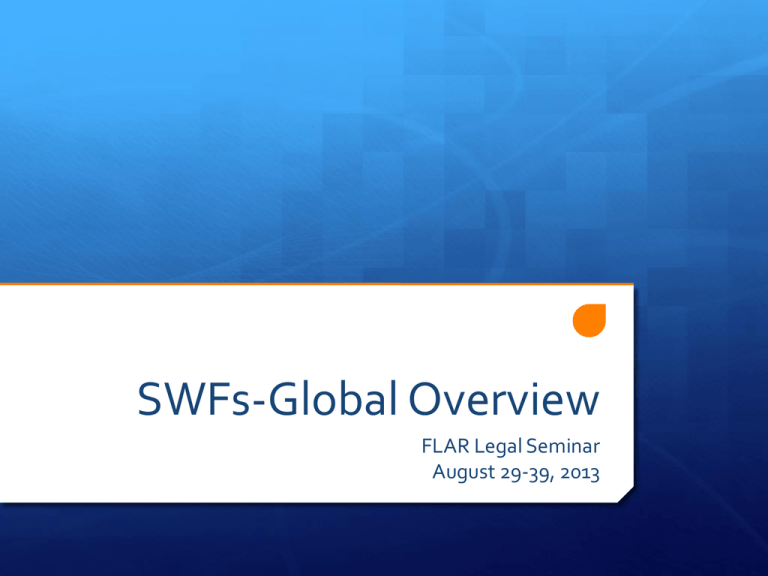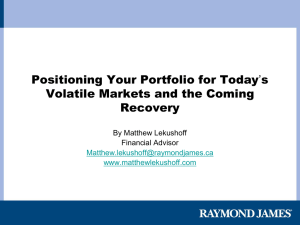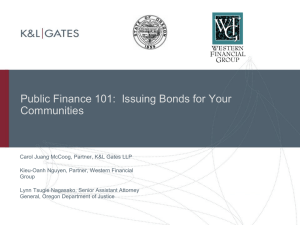Sovereign wealth funds-Global overview
advertisement

SWFs-Global Overview FLAR Legal Seminar August 29-39, 2013 Why sovereign wealth management? Revenues from extractive industries Fiscal smoothing of expenditures Permanent wealth/inter-generational equity Funding of future pension obligations Reserves accumulation from balance of payments surpluses Non-commodity funds • Cumulative fiscal or balance of payments surpluses fund US$2.1 trillion in long term investment funds for investment income and to meet future pension liabilities China-Africa Development fund Brazil - Sovereign Fund of Brazil 1/ New Zealand Superannuation Fund France- Strategic Investment Fund 1/ Ireland - National Pension Reserve Fund 1/ Malaysia- Khazanah Nasional Kazakhstan National Bank 1/ Korean Investment Corporation Australia-Future Fund China- National Security Fund Canada- CPP Investment Board Singapore- Tamasek Holdings Canada-Caisse de Depot et Plecement du Quebec Government of Singapore Investment Corporation Hong Kong Monetary Authority Investment Portfolio China Investment Corporation China -SAFE Investment Company 0 Source: Sovereign Wealth Fund institute 2011 1/ Central Banking Publications 100 200 300 400 US$ Billions 500 600 Commodity funds (oil and gas) • Revenues from extractive industries fund US$2.7 trillion Trinidad & Tobago -Heritage and Stabilization Fund 1/ Permanent Wyoming Mineral Trust Fund 1/ Saudi Arabia - Public Investment fund 1/ Timor-Leste Petroleum Fund Botswana-Pula Fund 1/ Oman-State General Reserve Fund Bahrain - Mumtalakat Holding Company 1/ Alberta's Heritage Savings Trust Fund Investment Corporation of Dubai Chile- Social and Economic Stabilization Fund 1/ Iran- National Development fund State Oil Fund of the Republic of Azerbaiiyan Brunei Investment Agency 1/ Kasakhstan National Fund 1/ Alaska Permanent Fund UAE-International Petroleum Investment Company Algeria - Revenue Regulation Fund 1/ Lybian Investment Authority Quatar Investment Authority Russia- National Welfare Funds Kuwait Investment Authority Saudi Arabia- SAMA Foreign Holdings Norway- Government Pension Fund Abu Dhabi Investment Authority 0 100 200 300 400 US$ Billions Source: Sovereign Wealth Fund institute 2011 1/ Central Banking Publications 500 600 700 Commodity Funds Objectives Fiscal stabilization Protect tradeable sector from currency appreciation Support current spending while investing long term for intergenerational equity Two types of funds Integrated fund that both supports current fiscal spending and invests long term for capital preservation and intergenerational equity Earmarked funds Stabilization fund for to smooth fiscal spending National pension fund to cover future pension liabilities Future funds (unpopular) Commodity Fund-Integrated • Funds structural budget deficit • Guidelines on withdrawals to preserve capital over time All commodity revenues Norway Abu Dhabi Saudi Arabia Kazakhstan Azerbaijan Alberta Timor-Leste Botswana Fund Budget Stabilization fund-earmarked Budget Chile Mongolia Russia Commodity revenues Fund Government establishes a threshold price level based on the expected long term average When the current prices exceeds the long term threshold price, “excess” revenues are paid into the Fund and can be drawn down during periods of below normal prices. Pension fund-earmarked National pension funds funded by contributions (plan) or by fiscal surpluses to meet future government pension obligations and invested in overseas assets New Zealand Superannuation Fund Australia Future Fund Chile Pension Reserve Fund Russia National Welfare Fund SWF Governance Fiduciary-beneficiary relationship Government as “sponsor” Enabling legislation Investment policy Investment process Transparency and reporting Oversight Statutory regulations and standards of care SWF Institutional Arrangements Regulation & delegation of authority Legislative Body Ministry Govt Auditor Executive Board Supervisory council/external auditor Asset Manager Risk, Control &Compliance Risk and performance reporting Norway’s Government Pension Fund Global Authorizing legislation Government Pension Fund Act 2005 Auditor General Ministry of Finance Council of Ethics Management mandate and Ethical Guidelines Governance Committee Norges Bank Executive Board Investment mandate and selection of CEO CEO Norges Bank Investment Management Implementation of Investment Policy Global Custodian Internal Managers External Managers 11 New Zealand Superannuation Fund New Zealand Superannuation and Retirement Income Act 2001 Ministry of Finance General Audit Appoints Board and sets strategic investment objectives Board of Guardians Sets Investment Policy, responsible investment guidelines, budget and appoints CEO CEO New Zealand Superannuation Fund Implements Investment policy Global Custodian Equity Managers Fixed income Managers Alternative Managers 12 Asset manager can be dedicated government agency or central bank Most governments have set up a dedicated government investment agency with its own governance, pay scale and specialized skill set Central bank as asset manager: Norway whereby the investment management corporation was embedded within the central bank Emerging market countries with little international investment infrastructure (East Timor, Botswana, Trinidad &Tobago) Stabilization funds that are invested in low risk strategies similar to investment of foreign currency reserves (Chile, Peru, Mexico) Policy alternatives to a sovereign wealth fund Domestic investment in state owned enterprises, development banks and jobs creation (not a good record but back in vogue) Public investment in infrastructure Direct dividend to citizens (or reduction in taxes) to foster private savings and investment National asset/liability management—foreign direct investment in “deficit” sectors; eg Chinese acquisition of commodity producers and agricultural land Sovereign Fund Investment Strategies Official Reserves/ Central Bank • External assets for directly financing international payment imbalances • Highly liquid, often OECD government bonds Stabilization Funds Pension Funds Sovereign Wealth Funds • Funds to insulate budget & economy from excess volatility, inflation, Dutch disease, & other macro economic threats •Investment vehicles to meet government’s future pension obligations • Investment • Companies in vehicles by which the state foreign exchange has significant assets control • Managed • May make separately from investments in official reserves foreign assets • Typically have a higher tolerance for risk • Low-risk, liquid assets: cash, government bonds •Funded and denominated in local currency Increasing investment horizon and investment risk Source: Monitor 2010 SWF Report State Owned Enterprises SWF Strategic Asset Allocation Australia Future Fund Alaska ADIA New Zealand Singapore GIC Risk Norway Global Trinidad Fixed income Chile Pension Equities Peru Stab Chile Stab Alternatives Expected return SAA is main driver of wealth generation and investment income 30 40% 25 30% 20 20% 15 10% 10 0% Return on a typical Central Bank Portfolio Return on a diversified Portfolio Cumulative Return on a typical Central Bank portfolio Cumulative Return on a Diversified Portfolio Jan-11 Jan-10 Jan-09 Jan-08 Jan-07 Jan-06 Jan-05 Jan-04 Jan-03 Jan-02 Jan-01 Jan-00 Jan-99 Jan-98 Jan-97 Jan-96 Jan-95 Jan-94 Jan-93 Jan-92 Jan-91 Jan-90 Jan-89 Jan-88 Jan-87 Jan-86 Jan-85 Jan-84 Jan-83 Jan-82 -20% Jan-81 0 Jan-80 -10% Jan-79 5 Typical Central Bank Portfolio: 100% US Government Bonds between 1-3yr ; Diversified Portfolio: 40% Developed Global Stocks/10% EM Stocks/5% EM Debt/5% Commodities/20% US Treasuries/20% US Corporate Bonds Source: World Bank Treasury calculations based on data on from Ibbotson Bloomberg Source: World Bank Treasury calculations based data fromAssociates Ibbotsonand Associates and Bloomberg 17 Annual Return Cumulative Wealth Balanced equity/bond vs government bond/cash portfolio (1979 – 2011) Diversification and modern capital markets theory But divide your investments among many places, for you do not know what risks might lie ahead. Bible, Ecclesiastes, 935 BC A portfolio of uncorrelated investments has a lower risk than any single investment Harry Markowitz, Modern Portfolio Theory, 1957 Modern paradigm of the prudent person rule “Prudence is to be found principally in the process by which investment strategies are developed, adopted, implemented, and monitored in light of the purposes for which funds are held, invested, and deployed. Prudence is demonstrated by the process through which risk is managed, rather than by the definition of specific risks that are imprudent. Under a modern paradigm, no investment is imprudent per se. The products and techniques of investment are essentially neutral. It is the way in which they are used, and how decisions as to their use are made, that should be examined to determine whether the prudence standard has been met. Even the most aggressive and unconventional investment should meet that standard if arrived at through a sound process, while the most conservative and traditional one may not measure up if a sound process is lacking.” Longstreth, B. “Modern Investment Management Theory and the Prudent Person Rule”,1986 Investment strategy by statute or regulation Blunt tool that may dictate Allowable asset classes Minimum rating for allowable investments Maximum exposure to a sector or investment (diversification by regulation) Portfolio diversification is required to meet long term riskadjusted return targets Highest return Lowest return 1976 - 1983 1983 - 1990 1990 - 1997 1997 - 2004 2004 - 2011 Real Estate Developed Equities EM Equities Real Estate EM Equities Developed Equities Commodities Real Estate Commodities EM Debt Commodities US Govt. Bonds US High Yield Bonds EM Debt US High Yield Bonds Cash US Corporate Bonds EM Debt US Corporate Bonds Real Estate US Corporate Bonds US High Yield Bonds Developed Equities US Govt. Bonds Commodities US Govt. Bonds Cash Commodities Developed Equities US Govt. Bonds Real Estate US Corporate Bonds US High Yield Bonds US Corporate Bonds US Govt. Bonds Cash Developed Equities Cash EM Equities Cash World Bank Treasury estimates Source: World Bank Treasury calculations based on data from Bloomberg How does the legal environment impact the SAA? Australia Alaska Future Fund ADIA New Zealand Norway Global Risk Singapore GIC Trinidad Chile Pension Azerbaijan East Timor Fixed income Equities Peru Stab Chile Stab Alternatives Expected return Threat of liability and impact on portfolio management Contemporary application of the prudent person rule (NZ, Alberta, Alaska, Australia) Focus on investment process Role of diversification Standards of behavior Statutory regulation of allowable investments Bright line that provides more protection and less scope for interpretation Asset allocation by parliament as “fiduciary” rather than by investment manager (Norway) Where the government is risk adverse or unprepared, can lead to highly sub-optimal portfolios (East Timor, Russia, Azerbaijan) Combination










